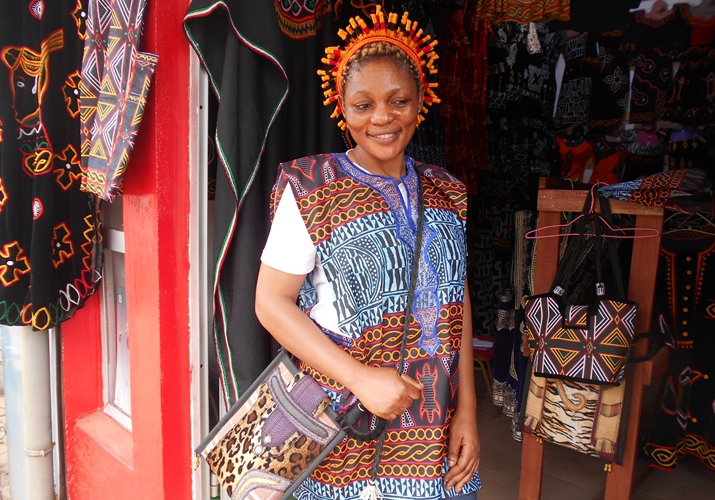
The Atoghu outfits represent Cameroon's best clothing

With its 10 regions, Cameroon has an impressive traditional clothing heritage: the Atoghu outfits famous for their diverse forms and color patterns. These traditional tunics are made of velvet fabric on which brightly colored patterns and ornaments are meticulously embroidered. The embroideries can represent different shapes ranging from diamonds to stars. The contrast between the dark background and the shimmering colors of the embroidery is what makes it so original.
From local to global
Originally from Bamenda, capital of Northwest Region, the Atoghu attire was usually worn by royalty and notables, both men and women, at weddings, celebrations, chieftaincy investitures, and other large-scale festivals. But over time, this traditional dress has spread beyond the elite and formal occasions and entered into the everyday life.
More recently, everyday use has necessitated the replacement of velvet with lighter fabrics. One of the first steps of modernization is the use of fabric with traditional patterns for modern designs. Large tunics are replaced by stylish dress outfits.
Very proud of their traditions and customs, the Cameroonians of the Northwest wear with elegance and refinement the cultural dress of their stock. In their modernized version, the tunics can take various forms, depending on the inspiration of the craftsman.
The traditional Atoghu suits are currently the best ambassadors of Cameroon's clothing on the international level and the amazing style is becoming the official attire of Cameroonian athletes. During major sporting events such as the Olympic Games, as in 2012 in London and 2016 in Rio de Janeiro, the world watched with admiration the style from the African country. Their appearances have not gone unnoticed at any event because they highlight Cameroon, Africa, and its know-how.
In addition, several global celebrities have also been fascinated by these traditional costumes, including the Obama couple. Stevie Wonder, the prince of pop music, wore a traditional Atoghu tunic during his visit to Cameroon in July 1992.
Each of Cameroon's regions has a plethora of high-end traditional dresses, and among the most prized are the Kaba Ngondo, the Sandja, the Ndop, and the Gandoura.

A reference label
Claude Fashion Traditional Designs is a boutique dedicated to selling the Atoghu attire. Located in Bastos, an upscale neighborhood in the capital Yaoundé, the famous boutique is managed by 39-year-old Claudette Djou. She left her hometown Bamenda in 2019 as a result of an armed conflict. The passion for fashion drove her to get more actively engaged in the traditional wear sector. Her store displays the Atoghu outfits on stands and mannequins.
According to the manager, her turnover is stable and the outfits are very much in demand by both local and expatriate clients. "My clientele is composed of people of different nationalities, from South Africa, Gabon, Europe, North America, and even Asia," she said. The prices of her items range from $100 to $250 per outfit for men, women, and children. High-end outfits sell for between $500 and $1,000 (for men or women), depending on the model and the time spent on making it.
She also explained that it can take a week to make an outfit for some models and a month or more for others. These outfits are usually accompanied by matching accessories such as hats, necklaces and handbags for men and women. A bag carries the price tag of $50 to $200. Hats cost between $50 and $150.

The Atoghu label is gaining market share internationally. Moussa Tamboura, originally from Burkina Faso, bought two Atoghu tunics, paying the sum of $600. And he does not hide his satisfaction. "I am a regular customer of this store. I appreciate these traditional tunics very much, and even in Burkina Faso, where I come from, everyone likes them very much because of their originality. They are very elegant outfits with great finesse."
The store is also popular with young people. Carine Tsogo, a student at a private university in Yaoundé, finds these traditional clothes very original and a clear improvement in quality and aesthetics. Despite her modest financial situation, she was able to buy an outfit worth $250. "Currently, I choose clothes from the traditional Cameroonian fashion in general. I have a preference for the Atoghu clothing, which is distinguished by the elegance of its designs and its international reputation. I hope that the Cameroonian Government will support our stylists in order to popularize our traditional clothing," suggested Tsogo.

Her friend Christina Akaba added, "The interest of Cameroonians in the ready-to-wear 'made in Cameroon' is gradually rising. In the past, Cameroonians were somewhat reluctant to wear traditional clothes, unlike the trend today. However, government support is necessary to raise the level of creativity in the local and traditional fashion for more young people to take an interest in this sector."
Receptive to all these calls, the Cameroonian Government has already taken steps to have Atoghu's exceptional know-how recognized at the international level. Thus, Cameroon has initiated the process of labeling geographical indication to garments since 2018 in order to guarantee Atoghu's natural association with Cameroon.
According to Yanick Yemga, a Cameroonian industrial property consultant, geographical indications of a brand are signs that serve to identify a product as originating from a territory, region, or locality. The quality, reputation, or any other characteristic of the product is essentially linked to the geographical origin.